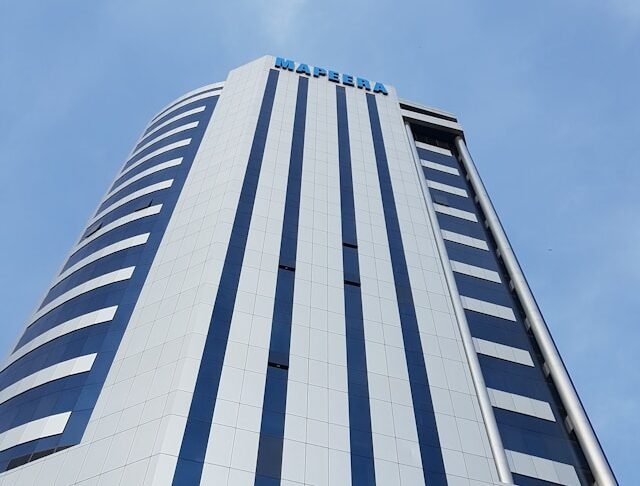Kampala has many wonders—monuments and buildings that feel like they’ve been around forever. Things like the Mapeera House, for example—doesn’t it just feel like it’s always been part of the city skyline? But have you ever stopped and asked yourself: what’s the actual story behind these structures? What history are we walking past every day without even knowing it?
Well, I did some digging for you. Let’s take a walk through Kampala’s most iconic and notable landmarks.
1. The Kasubi Tombs – Where Kings Rest.
If you’re looking for the cultural heart of Buganda, the Kasubi Tombs is where it all begins. Tucked away on Kasubi Hill, this site isn’t just a tourist attraction—it’s a sacred place that holds the remains of four former kings of Buganda (Kabakas), along with other royal family members.
Built in 1882 by Kabaka Mutesa I as his personal palace, the site was later turned into royal burial grounds following his death in 1884. What makes the Kasubi Tombs even more unique is its architecture—crafted almost entirely from organic materials like reeds, grass, bark cloth, and wood. The main structure, called Muzibu Azaala Mpanga, is considered one of the most spectacular examples of traditional Ganda architecture.
Unfortunately, in 2010, a fire severely damaged the tombs, triggering national mourning. But efforts led by both the Buganda Kingdom and UNESCO have since been underway to restore it.
Tombs of Buganda Kings at Kasubi
2. Gaddafi National Mosque
Perched atop Old Kampala Hill, the Gaddafi National Mosque is more than just a religious site—it’s a monument of international friendship and architectural marvel. Construction began in the early 2000s, but it was officially completed in 2006, fully funded by the late Libyan leader Muammar Gaddafi as a gift to the Ugandan Muslim community.
With a seating capacity of over 15,000 people, it’s the largest mosque in Uganda and among the largest in East Africa. The design is a captivating blend of Arabic, North African, and Ugandan architectural styles. The minaret, which towers above most of Kampala, offers a 360-degree panoramic view of the entire city—and it’s a favorite spot for photographers and tourists.
3. Independence Monument
You’ve probably passed by the Independence Monument a hundred times without giving it much thought—but it’s one of the most symbolic landmarks in Kampala.
Located near Sheraton Hotel on Speke Road, the monument was erected in 1962, right after Uganda gained independence from British colonial rule. The statue features a tall man unwrapping a child from bondage and raising it to the sky—signifying Uganda’s release from colonial rule and the birth of a free nation.
It was sculpted by Gregory Maloba, one of Uganda’s first professional sculptors, and funded by the British colonial government (ironically enough). Today, it’s a popular photo spot and a reminder of how far the country has come.
4. Mapeera House
Let’s talk about Mapeera House, that sleek glass building towering above downtown Kampala. While it looks ultra-modern, the history behind it dates back more than a century.
Named after Fr. Siméon Lourdel, better known as Father Mapeera, one of the first Catholic missionaries to set foot in Uganda in 1879, this building honors his contribution to the spread of Christianity in the region. The building itself is the headquarters of Centenary Bank, and it represents how far Ugandan Catholics have come—from humble beginnings in Namugongo to being a major part of the country’s socio-economic fabric.
Though modern in design, Mapeera House is deeply symbolic—combining faith, history, and economic growth all in one impressive structure.
Mapeera House: A Landmark in Banking
5. The Namirembe Cathedral
Namirembe Cathedral, also known as St. Paul’s Cathedral, is the oldest cathedral in Uganda and the mother church of the Anglican Church of Uganda. It sits gracefully on Namirembe Hill, offering stunning views of Kampala city.
Construction of the current cathedral began in 1915 after previous structures were destroyed by lightning and termites. It was completed in 1919 using red bricks and timber, with a simple yet grand colonial-era design. Its peaceful hilltop setting and ringing church bells give it a timeless aura.
This cathedral isn’t just a religious structure; it’s a spiritual home for generations of Anglicans and a testament to Uganda’s Christian roots.
6. The Rubaga Cathedral
Just across from Namirembe Hill, there’s Rubaga Cathedral, the seat of the Roman Catholic Archdiocese of Kampala. Built on Lubaga Hill, the majestic cathedral was completed in 1925 and remains one of the most beautiful and historically significant buildings in Kampala.
It stands on land that was once a palace of Kabaka Mutesa I before he gifted it to the Catholic missionaries. The architecture is Romanesque with red brick walls, large arches, and twin towers that dominate the skyline.
Rubaga Cathedral is not just a spiritual sanctuary but also the resting place of Archbishop Joseph Kiwanuka, the first African Catholic bishop in modern times.
Top Financial Habits Keeping Ugandans Broke – Stop Them Now!
7. Uganda Martyrs Shrine, Namugongo
The Uganda Martyrs Shrine in Namugongo commemorates 22 young Christian converts who were executed between 1885 and 1887 by Kabaka Mwanga II for their refusal to renounce their faith. The shrine marks the very site where St. Charles Lwanga and his companions were burned alive.
The current basilica-shaped shrine was completed in 1975 and is designed to resemble a traditional Baganda hut, with 22 copper pillars representing each martyr. Every year on June 3rd, millions of pilgrims from all over the world gather here to honor the martyrs in a moving display of faith and unity.
8. Uganda Museum
Located in Kamwokya, the Uganda Museum is the oldest museum in East Africa, established in 1908. It houses thousands of historical, ethnographic, and cultural artifacts that tell the story of Uganda’s diverse heritage.
From traditional musical instruments to ancient tools, tribal regalia, and colonial relics, this museum offers a walk through time. The architecture itself is a gem of 1950s modernism, and the open spaces make it great for student tours and curious explorers.
9. Baháʼí Temple
The Baháʼí Temple in Kampala is truly one-of-a-kind—literally. It’s the only Baháʼí House of Worship on the African continent, located on Kikaya Hill. Completed in 1961, the temple sits in the middle of a lush 52-acre garden, open to people of all faiths.
Its dome stands 38 meters high and symbolizes unity and oneness. The Baháʼí faith teaches global harmony, and this temple reflects that message through its simplicity and beauty.
A quiet retreat for reflection, it’s a lesser-known but deeply meaningful landmark.
10. Kabaka’s Palace (Lubiri) – The Seat of Kings and Secrets of the Past
The Kabaka’s Palace, also known as Lubiri Mengo, is the official residence of the King of Buganda. It sits on Mengo Hill and was first constructed in 1885 by Kabaka Mwanga II. While the king no longer resides there full-time, it remains an important symbol of Buganda’s monarchy.
The palace grounds include the infamous Amin torture chambers, a haunting reminder of Uganda’s darker days under dictatorship. These underground cells were used for imprisonment and torture during Idi Amin’s regime.
Despite its turbulent history, Lubiri remains a vital cultural landmark that honors both the glory and the trials of Uganda’s past.
The Best Kampala Landmarks and Monuments 2025
Do you have a favorite Kampala landmark I didn’t mention? Hit me up in the comments—I’d love to add it to the next edition. Let’s keep these stories alive.




